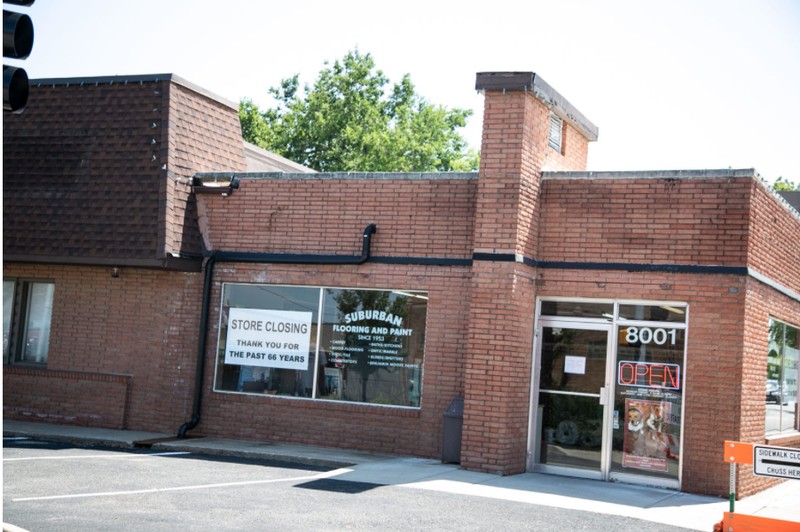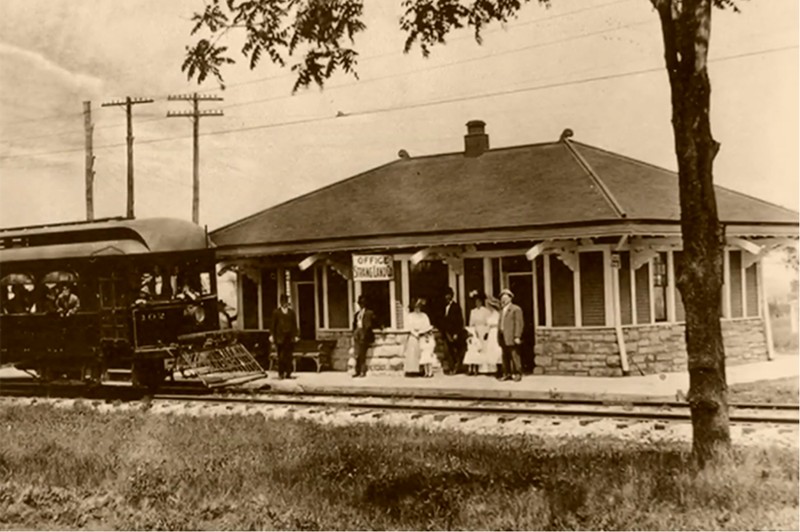Strang Depot
Introduction
Text-to-speech Audio
Construction of this interurban railway depot began in 1905 under the direction of William B. Strang, Jr., who is widely recognized as the founder of Overland Park, given the central role of his interurban railroad that connected this area to the growing city. Strang's Missouri & Kansas Interurban Railroad was also known as the "Stran Line" and this depot became the first commercial building in what would become Overland Park, Kansas. The first interurban rail car arrived in March 1906. The Overland Park Historical Society (OPHS) purchased this structure and plans to create a museum and community space that will feature a trolley car, exhibits, a conference room, an educational center, and archival facilities.
Images
Strang Depot site, 8001 Santa Fe Drive, Overland Park, Kansas 66204

Depot as it existed in the early 1900s.

Backstory and Context
Text-to-speech Audio
William B. Strang was an international builder of short-line railroads, urban developer, and gifted promoter. The 1903 floods of the Kansas and Missouri Rivers accelerated development on both sides of the state line, but it was the rapid population growth of Kansas City that was most responsible for the founding of Overland Park, Kansas.
Strang had offices on Wall Street and a Park Avenue, New York City residence. A popular story connecting Strant to the development of this community involves his widowed mother who lived in Kansas City at the time of the floods. A popular book on the early history of Overland Park includes a story that she approached her son and suggested that a city rail line could promote residential developments that would rescue her and others from the “awful stench of rotting carcasses” from the flooded stockyards that permeated the air of her Kansas City, Missouri, home. The story continues that Strang took his mother to the farm of his friend, George Metcalf, located several miles into the country and across the state line on Kansas Street, where she mentioned how good the air smelled and how happy she was that Strang had the idea to build a “planned parklike suburb there” where the air was clean and there was no chance of flooding (Oberg).
Strang’s vision of an interurban rail line followed similar patterns that led to the creation of trolley lines and suburbs such as Brookside and Waldo. With no natural barrier, former farmland could be purchased and developed with affordable homes away from the urban core as long as transportation networks were available. Strang’s first patented, self-propelled streetcar with no overhead wire was the first of its kind to be used on railroad tracks in the United States. The interurban line was officially called the Missouri & Kansas Interurban Railroad but known locally as the Strang Line,
That same year, in 1906, Strang purchased 600 acres that he named Overland Park. In August 1906, there was an auction with 83 parcels of land sold for as high as $380 (over $10,000 today). Strang acquired more land and planned and promoted additional developments. The Strang Depot on the interurban line was the first commercial building in Overland Park, Kansas.
In the next century, this building was expanded and remodeled, with the original walls covered. The Overland Park Historical Society purchased the structure and pulled back some of the walls to reveal the stone walls from 1906 along with original wainscoting and lap siding. The group plans to create a museum and community space that will offer exhibits, educational programs, and an archive.
Cite This Entry
Cuevas Hoffmann, Dana and Clio Admin. "Strang Depot." Clio: Your Guide to History. June 14, 2024. Accessed March 19, 2025. https://theclio.com/tour/1012/18
Sources
Oberg, Suzee SoldanEls and the Overland Park Historical Society. Images of America: Overland Park. Charleston, SC, Arcadia Publishing, 2012.
Senter, Jay. “Overland Park Historical Society closes on purchase of Strang Depot building, finds part of original 1906 structure intact.” Johnson County Post, August 29, 2019.
Johnson Couty Post
Overland Park Historical Society

